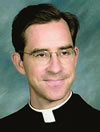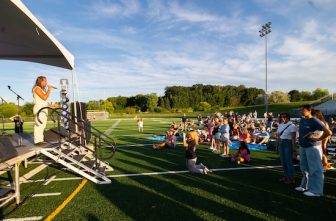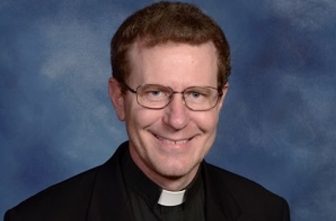Catholic Spirit editor Joe Towalski recently interviewed Father Peter Laird and Father John Bauer, co-chairs of the archdiocesan Strategic Planning Task Force, appointed by Archbishop John Nienstedt in February 2009. Last July, the 16-member task force made its planning recommendations to the archbishop.
The archbishop had guiding principles for the planning process. Did you have guiding principles as well as you led the task force in its work?

Father Bauer: We tried to get as much information as we could. If task force members wanted something, we tried to give them information so they could make decisions with clarity and with all the background information and materials they would find helpful.
Father Laird: The principles that the archbishop gave us made it clear that we weren’t doing a corporate reorganization. We were doing a reorganization of a community of faith. . . . I think one of the things that became clear was because it is a family that’s being in a certain sense reorganized, that every member of the family would be affected. So, I think the task force, at least implicitly, very much believed that this [strategic plan] is for the whole archdiocese — it’s not for the rural areas, it’s not for the urban areas; it’s for the whole archdiocese.
What was the biggest challenge of all this?

Father Laird: These are emotional issues. I don’t mean merely emotional issues — our faith is always connected to our values and our beliefs, and we are an incarnational church after all. We were aware that we were dealing with decisions that will affect people’s lives. The prospect of a merger or the prospect of a cluster, that’s going to change the pattern of people’s lives, and change is never easy.
We wanted to respect the fact that people had been fed and nourished in various ways in the history of the archdiocese. It’s just that, moving forward, we may need to do that in a new way. And that was the hardest [challenge], I think.
Father Bauer: And knowing that’s going to affect our brother priests is another piece of that. We have small enough numbers that we know everyone, and we know the ones that are going to be impacted by it.
What is the biggest thing you learned from going through this process, either about the archdiocese or the church in general?
Father Bauer: I learned how much people care about their parishes, about their faith. It was reflective on all different levels, including the work of the task force. We were going to have an upcoming deanery presentation, and one of our members who wasn’t familiar with that part of the archdiocese actually went out and toured it so she would have a better awareness. People really cared about what they did and took it very seriously.
Father Laird: I think part of that learning process for me personally was that a lot of good work has been done in parishes. There are parishes and pastors and lay people in this archdiocese who have been thinking strategically for a long time. And they’re tremendous gifts in the archdiocese that we’ll have to [utilize] going forward. So it’s not just the archdiocese that is all of a sudden doing strategic thinking, there are a lot of people doing strategic thinking.
Secondly, [there is] a transition going on in the church in my mind, away from a buildings-first to more of a relational-first church. . . . I think there were a lot of wonderful things about the church in the ‘40s and ‘50s and ‘60s, but it tended to be what I would call building-centric, edifice-centric. I think what may have been lost in that is the relationship center of our faith. In the end, it’s not buildings that feed the poor or educate the young or minister to the grieving. It’s people — priests, religious, lay people. And those people in turn — the poor, the elderly, the grieving — minister also to us.
There were dozens of public meetings held around the archdiocese regarding the plan since spring 2009. Did you hear anything at these meetings that influenced the content of the final plan?
Father Laird: People have an experience of church almost peculiar and particular to the person who experiences it. What that told us is that people wanted a unity in faith and yet an appropriate sort of diversity of expression. I think that’s something the strategic planning task force did a very good job on. We have small parishes in the archdiocese coming out in the plan and we have large parishes. I think it confirmed our own work, that we weren’t out to have a cookie-cutter approach to the archdiocese.
Father Bauer: I go back to what I think we heard in those meetings, which is what I said earlier about how much people cared about their parishes and their faith. We really took that seriously. It would have been very easy to make recommendations based on real cut-and-dried kind of things, but we really tried to listen to what the needs were of, say, this parish, this deanery — the priests and the people — and then to form recommendations out of that.
Outside of clustering, merging, etc., there are a number of other elements in the plan — sections addressing continuing education for clergy and laity, parish administration, outreach to the Latino community. How were these areas identified as planning priorities?
Father Bauer: Early on, we divided our work into three subcommittees: one on education and schools, the second on administration and finance, and the third on ministry in general. Out of those subcommittees came recommendations to the task force that we then worked with and passed on to the archbishop.
Part of those recommendations were around ministries to certain specific groups, like Latino ministry (see print edition page 18A), ministry to prisons, chaplaincies and . . . competencies for ministry for both ordained and lay (see print edition pages 7A and 16A). We’re still doing some work with a consulting firm on the recommendations for our schools (see print edition pages 8A and 9A).
How much of an influence on your recommendations were financial issues facing parishes and the archdiocese?
Father Bauer: There’s no doubt that the finances of some of our parishes were a major factor in some of our recommendations, but I would not want to put that issue as front-burner for all our recommendations. Certainly it was in the background as we looked at some of our parishes. But in terms of the whole breadth of our recommendations, it was one among many issues that we looked at.
How do you think the archdiocese will be different 10 years from now because of this plan?
Father Bauer: I think we’ll be a more vibrant, stronger archdiocese in a variety of different ways in terms of how we look at ministry to the people of the archdiocese [and] how we provide the services and the programs that we do. I think we’ll see more coordination of those. I think we’ll see a leaner church in terms of our administrative structure and parish-wise. There will be more collaboration.
Father Laird: I think in 10 years time, hopefully, it’s an archdiocese that more effectively teaches the Gospel and has an even greater excellence in Catholic education than it does now, that has parishes that are more vibrant in their expression not only of the sacramental life of the church but also in reaching out to the poor. Because the strategic planning process isn’t about turning inward. It’s about, as the church always has the responsibility to do, reading the signs of the times and adjusting the household of faith to engage the world even more vibrantly and more completely.
Some people will be experiencing feelings of loss, sadness and anger when they see the plan, particularly if their parish is losing autonomy or being merged with another. What would you say to a person in this situation?
Father Laird: The first thing I’d say is, “This is not done lightly, and it surely was not done in any way to diminish your experience of the church. In fact, it’s just the opposite. I realize that it’s going to take time for you to come to that realization and I want to help you through that process. . . . I want to hear what you loved about your parish, and then I want to invite you to make the same investment in this parish that you made in that parish.”
Are pastors where changes are happening going to be getting some help to address this with their parishioners?
Father Bauer: Our Parish Services Team . . . continues to do work right now. In fact, there is a workshop planned for pastors of merged parishes [this week]
. . . to say here are some of the things you need to start working on right now. [The PST] will also be looking at other education pieces to help parishes and priests that are going to have to deal with this.




